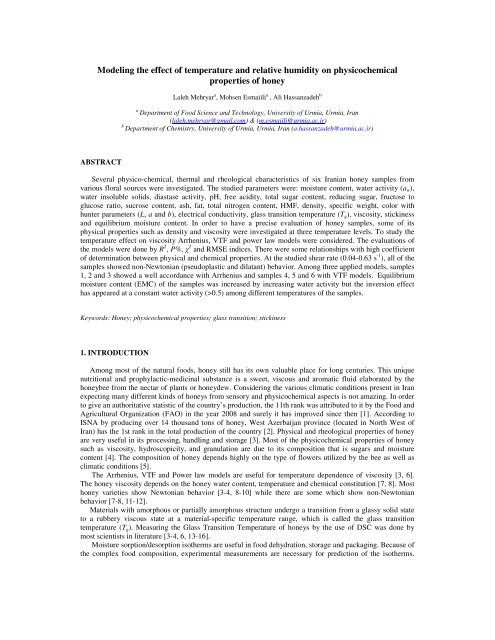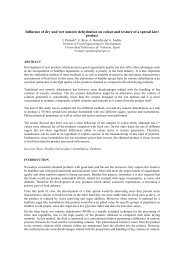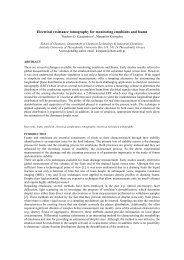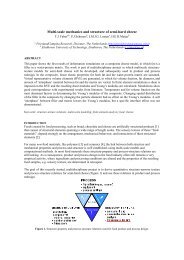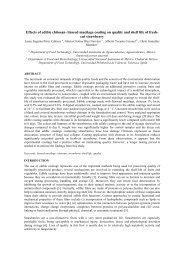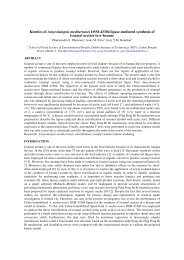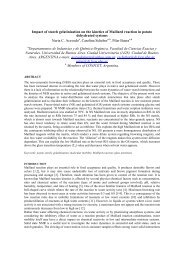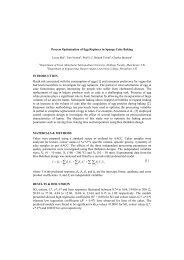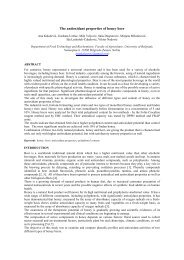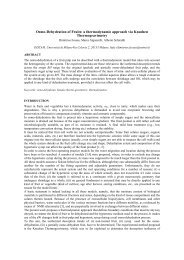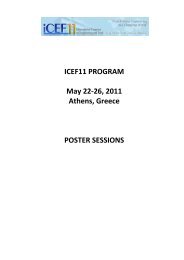Modeling the effect of temperature and relative humidity on ...
Modeling the effect of temperature and relative humidity on ...
Modeling the effect of temperature and relative humidity on ...
Create successful ePaper yourself
Turn your PDF publications into a flip-book with our unique Google optimized e-Paper software.
<str<strong>on</strong>g>Modeling</str<strong>on</strong>g> <str<strong>on</strong>g>the</str<strong>on</strong>g> <str<strong>on</strong>g>effect</str<strong>on</strong>g> <str<strong>on</strong>g>of</str<strong>on</strong>g> <str<strong>on</strong>g>temperature</str<strong>on</strong>g> <str<strong>on</strong>g>and</str<strong>on</strong>g> <str<strong>on</strong>g>relative</str<strong>on</strong>g> <str<strong>on</strong>g>humidity</str<strong>on</strong>g> <strong>on</strong> physicochemical<br />
properties <str<strong>on</strong>g>of</str<strong>on</strong>g> h<strong>on</strong>ey<br />
Laleh Mehryar a , Mohsen Esmaiili a , Ali Hassanzadeh b<br />
a<br />
Department <str<strong>on</strong>g>of</str<strong>on</strong>g> Food Science <str<strong>on</strong>g>and</str<strong>on</strong>g> Technology, University <str<strong>on</strong>g>of</str<strong>on</strong>g> Urmia, Urmia, Iran<br />
(laleh.mehryar@gmail.com) & (m.esmaiili@urmia.ac.ir)<br />
b<br />
Department <str<strong>on</strong>g>of</str<strong>on</strong>g> Chemistry, University <str<strong>on</strong>g>of</str<strong>on</strong>g> Urmia, Urmia, Iran (a.hassanzadeh@urmia.ac.ir)<br />
ABSTRACT<br />
Several physico-chemical, <str<strong>on</strong>g>the</str<strong>on</strong>g>rmal <str<strong>on</strong>g>and</str<strong>on</strong>g> rheological characteristics <str<strong>on</strong>g>of</str<strong>on</strong>g> six Iranian h<strong>on</strong>ey samples from<br />
various floral sources were investigated. The studied parameters were: moisture c<strong>on</strong>tent, water activity (a w ),<br />
water insoluble solids, diastase activity, pH, free acidity, total sugar c<strong>on</strong>tent, reducing sugar, fructose to<br />
glucose ratio, sucrose c<strong>on</strong>tent, ash, fat, total nitrogen c<strong>on</strong>tent, HMF, density, specific weight, color with<br />
hunter parameters (L, a <str<strong>on</strong>g>and</str<strong>on</strong>g> b), electrical c<strong>on</strong>ductivity, glass transiti<strong>on</strong> <str<strong>on</strong>g>temperature</str<strong>on</strong>g> (T g ), viscosity, stickiness<br />
<str<strong>on</strong>g>and</str<strong>on</strong>g> equilibrium moisture c<strong>on</strong>tent. In order to have a precise evaluati<strong>on</strong> <str<strong>on</strong>g>of</str<strong>on</strong>g> h<strong>on</strong>ey samples, some <str<strong>on</strong>g>of</str<strong>on</strong>g> its<br />
physical properties such as density <str<strong>on</strong>g>and</str<strong>on</strong>g> viscosity were investigated at three <str<strong>on</strong>g>temperature</str<strong>on</strong>g> levels. To study <str<strong>on</strong>g>the</str<strong>on</strong>g><br />
<str<strong>on</strong>g>temperature</str<strong>on</strong>g> <str<strong>on</strong>g>effect</str<strong>on</strong>g> <strong>on</strong> viscosity Arrhenius, VTF <str<strong>on</strong>g>and</str<strong>on</strong>g> power law models were c<strong>on</strong>sidered. The evaluati<strong>on</strong>s <str<strong>on</strong>g>of</str<strong>on</strong>g><br />
<str<strong>on</strong>g>the</str<strong>on</strong>g> models were d<strong>on</strong>e by R 2 , P%, χ 2 <str<strong>on</strong>g>and</str<strong>on</strong>g> RMSE indices. There were some relati<strong>on</strong>ships with high coefficient<br />
<str<strong>on</strong>g>of</str<strong>on</strong>g> determinati<strong>on</strong> between physical <str<strong>on</strong>g>and</str<strong>on</strong>g> chemical properties. At <str<strong>on</strong>g>the</str<strong>on</strong>g> studied shear rate (0.04-0.63 s -1 ), all <str<strong>on</strong>g>of</str<strong>on</strong>g> <str<strong>on</strong>g>the</str<strong>on</strong>g><br />
samples showed n<strong>on</strong>-Newt<strong>on</strong>ian (pseudoplastic <str<strong>on</strong>g>and</str<strong>on</strong>g> dilatant) behavior. Am<strong>on</strong>g three applied models, samples<br />
1, 2 <str<strong>on</strong>g>and</str<strong>on</strong>g> 3 showed a well accordance with Arrhenius <str<strong>on</strong>g>and</str<strong>on</strong>g> samples 4, 5 <str<strong>on</strong>g>and</str<strong>on</strong>g> 6 with VTF models. Equilibrium<br />
moisture c<strong>on</strong>tent (EMC) <str<strong>on</strong>g>of</str<strong>on</strong>g> <str<strong>on</strong>g>the</str<strong>on</strong>g> samples was increased by increasing water activity but <str<strong>on</strong>g>the</str<strong>on</strong>g> inversi<strong>on</strong> <str<strong>on</strong>g>effect</str<strong>on</strong>g><br />
has appeared at a c<strong>on</strong>stant water activity (>0.5) am<strong>on</strong>g different <str<strong>on</strong>g>temperature</str<strong>on</strong>g>s <str<strong>on</strong>g>of</str<strong>on</strong>g> <str<strong>on</strong>g>the</str<strong>on</strong>g> samples.<br />
Keywords: H<strong>on</strong>ey; physicochemical properties; glass transiti<strong>on</strong>; stickiness<br />
1. INTRODUCTION<br />
Am<strong>on</strong>g most <str<strong>on</strong>g>of</str<strong>on</strong>g> <str<strong>on</strong>g>the</str<strong>on</strong>g> natural foods, h<strong>on</strong>ey still has its own valuable place for l<strong>on</strong>g centuries. This unique<br />
nutriti<strong>on</strong>al <str<strong>on</strong>g>and</str<strong>on</strong>g> prophylactic-medicinal substance is a sweet, viscous <str<strong>on</strong>g>and</str<strong>on</strong>g> aromatic fluid elaborated by <str<strong>on</strong>g>the</str<strong>on</strong>g><br />
h<strong>on</strong>eybee from <str<strong>on</strong>g>the</str<strong>on</strong>g> nectar <str<strong>on</strong>g>of</str<strong>on</strong>g> plants or h<strong>on</strong>eydew. C<strong>on</strong>sidering <str<strong>on</strong>g>the</str<strong>on</strong>g> various climatic c<strong>on</strong>diti<strong>on</strong>s present in Iran<br />
expecting many different kinds <str<strong>on</strong>g>of</str<strong>on</strong>g> h<strong>on</strong>eys from sensory <str<strong>on</strong>g>and</str<strong>on</strong>g> physicochemical aspects is not amazing. In order<br />
to give an authoritative statistic <str<strong>on</strong>g>of</str<strong>on</strong>g> <str<strong>on</strong>g>the</str<strong>on</strong>g> country’s producti<strong>on</strong>, <str<strong>on</strong>g>the</str<strong>on</strong>g> 11th rank was attributed to it by <str<strong>on</strong>g>the</str<strong>on</strong>g> Food <str<strong>on</strong>g>and</str<strong>on</strong>g><br />
Agricultural Organizati<strong>on</strong> (FAO) in <str<strong>on</strong>g>the</str<strong>on</strong>g> year 2008 <str<strong>on</strong>g>and</str<strong>on</strong>g> surely it has improved since <str<strong>on</strong>g>the</str<strong>on</strong>g>n [1]. According to<br />
ISNA by producing over 14 thous<str<strong>on</strong>g>and</str<strong>on</strong>g> t<strong>on</strong>s <str<strong>on</strong>g>of</str<strong>on</strong>g> h<strong>on</strong>ey, West Azerbaijan province (located in North West <str<strong>on</strong>g>of</str<strong>on</strong>g><br />
Iran) has <str<strong>on</strong>g>the</str<strong>on</strong>g> 1st rank in <str<strong>on</strong>g>the</str<strong>on</strong>g> total producti<strong>on</strong> <str<strong>on</strong>g>of</str<strong>on</strong>g> <str<strong>on</strong>g>the</str<strong>on</strong>g> country [2]. Physical <str<strong>on</strong>g>and</str<strong>on</strong>g> rheological properties <str<strong>on</strong>g>of</str<strong>on</strong>g> h<strong>on</strong>ey<br />
are very useful in its processing, h<str<strong>on</strong>g>and</str<strong>on</strong>g>ling <str<strong>on</strong>g>and</str<strong>on</strong>g> storage [3]. Most <str<strong>on</strong>g>of</str<strong>on</strong>g> <str<strong>on</strong>g>the</str<strong>on</strong>g> physicochemical properties <str<strong>on</strong>g>of</str<strong>on</strong>g> h<strong>on</strong>ey<br />
such as viscosity, hydroscopicity, <str<strong>on</strong>g>and</str<strong>on</strong>g> granulati<strong>on</strong> are due to its compositi<strong>on</strong> that is sugars <str<strong>on</strong>g>and</str<strong>on</strong>g> moisture<br />
c<strong>on</strong>tent [4]. The compositi<strong>on</strong> <str<strong>on</strong>g>of</str<strong>on</strong>g> h<strong>on</strong>ey depends highly <strong>on</strong> <str<strong>on</strong>g>the</str<strong>on</strong>g> type <str<strong>on</strong>g>of</str<strong>on</strong>g> flowers utilized by <str<strong>on</strong>g>the</str<strong>on</strong>g> bee as well as<br />
climatic c<strong>on</strong>diti<strong>on</strong>s [5].<br />
The Arrhenius, VTF <str<strong>on</strong>g>and</str<strong>on</strong>g> Power law models are useful for <str<strong>on</strong>g>temperature</str<strong>on</strong>g> dependence <str<strong>on</strong>g>of</str<strong>on</strong>g> viscosity [3, 6].<br />
The h<strong>on</strong>ey viscosity depends <strong>on</strong> <str<strong>on</strong>g>the</str<strong>on</strong>g> h<strong>on</strong>ey water c<strong>on</strong>tent, <str<strong>on</strong>g>temperature</str<strong>on</strong>g> <str<strong>on</strong>g>and</str<strong>on</strong>g> chemical c<strong>on</strong>stituti<strong>on</strong> [7, 8]. Most<br />
h<strong>on</strong>ey varieties show Newt<strong>on</strong>ian behavior [3-4, 8-10] while <str<strong>on</strong>g>the</str<strong>on</strong>g>re are some which show n<strong>on</strong>-Newt<strong>on</strong>ian<br />
behavior [7-8, 11-12].<br />
Materials with amorphous or partially amorphous structure undergo a transiti<strong>on</strong> from a glassy solid state<br />
to a rubbery viscous state at a material-specific <str<strong>on</strong>g>temperature</str<strong>on</strong>g> range, which is called <str<strong>on</strong>g>the</str<strong>on</strong>g> glass transiti<strong>on</strong><br />
<str<strong>on</strong>g>temperature</str<strong>on</strong>g> (T g ). Measuring <str<strong>on</strong>g>the</str<strong>on</strong>g> Glass Transiti<strong>on</strong> Temperature <str<strong>on</strong>g>of</str<strong>on</strong>g> h<strong>on</strong>eys by <str<strong>on</strong>g>the</str<strong>on</strong>g> use <str<strong>on</strong>g>of</str<strong>on</strong>g> DSC was d<strong>on</strong>e by<br />
most scientists in literature [3-4, 6, 13-16].<br />
Moisture sorpti<strong>on</strong>/desorpti<strong>on</strong> iso<str<strong>on</strong>g>the</str<strong>on</strong>g>rms are useful in food dehydrati<strong>on</strong>, storage <str<strong>on</strong>g>and</str<strong>on</strong>g> packaging. Because <str<strong>on</strong>g>of</str<strong>on</strong>g><br />
<str<strong>on</strong>g>the</str<strong>on</strong>g> complex food compositi<strong>on</strong>, experimental measurements are necessary for predicti<strong>on</strong> <str<strong>on</strong>g>of</str<strong>on</strong>g> <str<strong>on</strong>g>the</str<strong>on</strong>g> iso<str<strong>on</strong>g>the</str<strong>on</strong>g>rms.
Although <str<strong>on</strong>g>the</str<strong>on</strong>g>re have exists more studies about moisture iso<str<strong>on</strong>g>the</str<strong>on</strong>g>rms <str<strong>on</strong>g>of</str<strong>on</strong>g> lots <str<strong>on</strong>g>of</str<strong>on</strong>g> foodstuffs, but still in h<strong>on</strong>ey case<br />
<str<strong>on</strong>g>the</str<strong>on</strong>g>re have been d<strong>on</strong>e little or no work [17].<br />
Stickiness is a phenomen<strong>on</strong> that reflects <str<strong>on</strong>g>the</str<strong>on</strong>g> tendency <str<strong>on</strong>g>of</str<strong>on</strong>g> some materials to agglomerate <str<strong>on</strong>g>and</str<strong>on</strong>g>/or adhere to<br />
c<strong>on</strong>tact surfaces. Its c<strong>on</strong>trol is critical for proper operati<strong>on</strong>s in Food Industries. So far little attenti<strong>on</strong> has been<br />
given to <str<strong>on</strong>g>the</str<strong>on</strong>g> cohesi<strong>on</strong> <str<strong>on</strong>g>and</str<strong>on</strong>g> adhesi<strong>on</strong> phenomena that c<strong>on</strong>tribute to stickiness.<br />
In order to know <str<strong>on</strong>g>the</str<strong>on</strong>g> characteristics <str<strong>on</strong>g>and</str<strong>on</strong>g> properties <str<strong>on</strong>g>of</str<strong>on</strong>g> h<strong>on</strong>ey, to maintain or improve its quality, <str<strong>on</strong>g>the</str<strong>on</strong>g> present<br />
study has been undertaken to determine <str<strong>on</strong>g>the</str<strong>on</strong>g> most important chemical, physical <str<strong>on</strong>g>and</str<strong>on</strong>g> rheological properties <str<strong>on</strong>g>of</str<strong>on</strong>g><br />
Iranian h<strong>on</strong>ey <str<strong>on</strong>g>and</str<strong>on</strong>g> <str<strong>on</strong>g>the</str<strong>on</strong>g>refore to study <str<strong>on</strong>g>the</str<strong>on</strong>g> relati<strong>on</strong>ships between <str<strong>on</strong>g>the</str<strong>on</strong>g> <str<strong>on</strong>g>temperature</str<strong>on</strong>g> <str<strong>on</strong>g>and</str<strong>on</strong>g> its physicochemical <str<strong>on</strong>g>and</str<strong>on</strong>g><br />
calorimetric properties.<br />
2. MATERIALS & METHODS<br />
2.1 Samples<br />
Six varieties <str<strong>on</strong>g>of</str<strong>on</strong>g> West Azerbaijan regi<strong>on</strong>s’ h<strong>on</strong>eys were provided by <str<strong>on</strong>g>the</str<strong>on</strong>g> Agricultural Organizati<strong>on</strong> with<br />
guaranteed botanic <str<strong>on</strong>g>and</str<strong>on</strong>g> natural origin. Preparati<strong>on</strong> <str<strong>on</strong>g>of</str<strong>on</strong>g> <str<strong>on</strong>g>the</str<strong>on</strong>g> samples was d<strong>on</strong>e according to <str<strong>on</strong>g>the</str<strong>on</strong>g> related AOAC<br />
method [18].<br />
In <str<strong>on</strong>g>the</str<strong>on</strong>g> following part <str<strong>on</strong>g>the</str<strong>on</strong>g> methods, applied instruments <str<strong>on</strong>g>and</str<strong>on</strong>g> <str<strong>on</strong>g>the</str<strong>on</strong>g> related equati<strong>on</strong>s <str<strong>on</strong>g>of</str<strong>on</strong>g> <str<strong>on</strong>g>the</str<strong>on</strong>g> parameters are<br />
summarized:<br />
2.2 Moisture c<strong>on</strong>tent: (AOAC, Method 969.38)-(NAR-3T, Atago, Japan Abbe Refractometer) [18]<br />
2.3 Water activity (a w ) (25.18 o C): Ms1-a w , Novasina, Switzerl<str<strong>on</strong>g>and</str<strong>on</strong>g>, water activity meter<br />
2.4 Water insoluble solids: (Internati<strong>on</strong>al H<strong>on</strong>ey Commissi<strong>on</strong> <str<strong>on</strong>g>and</str<strong>on</strong>g> ISIRI, No.92) [19, 20]<br />
2.5 Diastase c<strong>on</strong>tent: (AOAC, Method 958.09) [18]<br />
2.6 pH <str<strong>on</strong>g>and</str<strong>on</strong>g> free acidity: (AOAC, Method 962.19)- (INOLABPH720, WTW, Germany, pH meter) [18]<br />
2.7 Sugar c<strong>on</strong>tents: (Internati<strong>on</strong>al H<strong>on</strong>ey Commissi<strong>on</strong> <str<strong>on</strong>g>and</str<strong>on</strong>g> ISIRI, No.92) [19, 20]<br />
2.8 Ash c<strong>on</strong>tent: (AOAC, Method 920.181)- (FMS4, Fan Azma Gostar, Iran) [18]<br />
2.9 Total nitrogen c<strong>on</strong>tent: (AOAC, Method 962.18)- (V40, Bakhshi, Iran) [18]<br />
2.10 Fat c<strong>on</strong>tent: (Soxhlet method [21])-( Bakhshi, Iran)<br />
2.11 HMF c<strong>on</strong>tent: (Internati<strong>on</strong>al H<strong>on</strong>ey Commissi<strong>on</strong> <str<strong>on</strong>g>and</str<strong>on</strong>g> ISIRI, No.92) [19, 20]<br />
2.12 Density: (Mass to volume ratio [22])-(Calibrated density bottle with <str<strong>on</strong>g>the</str<strong>on</strong>g>rmometer – 25ml, ISO-Lab,<br />
Germany).<br />
Specific gravity <str<strong>on</strong>g>of</str<strong>on</strong>g> <str<strong>on</strong>g>the</str<strong>on</strong>g> samples was calculated by dividing <str<strong>on</strong>g>the</str<strong>on</strong>g> h<strong>on</strong>ey density value to <str<strong>on</strong>g>the</str<strong>on</strong>g> density <str<strong>on</strong>g>of</str<strong>on</strong>g><br />
distilled water at a st<str<strong>on</strong>g>and</str<strong>on</strong>g>ard <str<strong>on</strong>g>temperature</str<strong>on</strong>g> [23]). The h<strong>on</strong>ey density was <str<strong>on</strong>g>the</str<strong>on</strong>g>n calculated according to <str<strong>on</strong>g>the</str<strong>on</strong>g><br />
following equati<strong>on</strong> (derived from <str<strong>on</strong>g>the</str<strong>on</strong>g> pears<strong>on</strong>'s square <str<strong>on</strong>g>and</str<strong>on</strong>g> mass balance basis):<br />
ρm<br />
× ρ<br />
w<br />
ρ<br />
H<br />
= (1)<br />
2 ρ<br />
w<br />
− ρm<br />
Where ρ H is <str<strong>on</strong>g>the</str<strong>on</strong>g> density <str<strong>on</strong>g>of</str<strong>on</strong>g> h<strong>on</strong>ey (g.cm -3 ), ρ m is <str<strong>on</strong>g>the</str<strong>on</strong>g> density <str<strong>on</strong>g>of</str<strong>on</strong>g> <str<strong>on</strong>g>the</str<strong>on</strong>g> diluted mixture (g.cm -3 ) <str<strong>on</strong>g>and</str<strong>on</strong>g> ρ w is <str<strong>on</strong>g>the</str<strong>on</strong>g><br />
density <str<strong>on</strong>g>of</str<strong>on</strong>g> <str<strong>on</strong>g>the</str<strong>on</strong>g> distilled water (g.cm -3 ).<br />
The experimental density data were correlated with <str<strong>on</strong>g>temperature</str<strong>on</strong>g> (T, o C) <str<strong>on</strong>g>and</str<strong>on</strong>g> dry matter (DM, g/100g),<br />
using n<strong>on</strong>-linear regressi<strong>on</strong> method <str<strong>on</strong>g>and</str<strong>on</strong>g> by <str<strong>on</strong>g>the</str<strong>on</strong>g> Levenberg-Marquardt estimati<strong>on</strong> method, supplied in <str<strong>on</strong>g>the</str<strong>on</strong>g><br />
STATISTICA s<str<strong>on</strong>g>of</str<strong>on</strong>g>tware release 7.<br />
2.13 Color: (Minolta, CR-410, Japan)<br />
2.14 Electrical c<strong>on</strong>ductivity: (Internati<strong>on</strong>al H<strong>on</strong>ey Commissi<strong>on</strong>)-(AZ-86P3, ACCURACY THE ZENIT,<br />
Taiwan) [19]<br />
2.15 Glass transiti<strong>on</strong> <str<strong>on</strong>g>temperature</str<strong>on</strong>g> (T g ): (Thermal scan range: -100 to +140 o C, Scan rate: 5 o Cmin -1 )<br />
(METTLER.Star s<str<strong>on</strong>g>of</str<strong>on</strong>g>tware 9.10, USA)<br />
2.16 Dynamic viscosity: (BROOKFIELD, DV-II+Pro No. M/03-165-b0707, viscometer)<br />
2 2<br />
2ω<br />
R . R<br />
(R<br />
c s<br />
s < r
2.16.1 VTF model:<br />
µ<br />
⎡ B<br />
= A.exp⎢<br />
⎢⎣<br />
( T −<br />
T g<br />
⎤<br />
⎥<br />
) ⎥⎦<br />
Where µ is <str<strong>on</strong>g>the</str<strong>on</strong>g> viscosity (Pa.s) at <str<strong>on</strong>g>temperature</str<strong>on</strong>g> T ( o K), A (Pa.s) <str<strong>on</strong>g>and</str<strong>on</strong>g> B are c<strong>on</strong>stants <str<strong>on</strong>g>and</str<strong>on</strong>g> T g is glass<br />
transiti<strong>on</strong> <str<strong>on</strong>g>temperature</str<strong>on</strong>g> ( o K).<br />
B<br />
2.16.2 Power law model: µ = A ( T − )<br />
(5)<br />
T g<br />
Where µ is <str<strong>on</strong>g>the</str<strong>on</strong>g> viscosity (Pa.s) at <str<strong>on</strong>g>temperature</str<strong>on</strong>g> T ( o K), A <str<strong>on</strong>g>and</str<strong>on</strong>g> B are c<strong>on</strong>stants <str<strong>on</strong>g>and</str<strong>on</strong>g> T g is glass transiti<strong>on</strong><br />
<str<strong>on</strong>g>temperature</str<strong>on</strong>g> ( o K).<br />
−<br />
2.16.3 Arrhenius model:<br />
Ea<br />
µ = A.exp(<br />
)<br />
(6)<br />
R.<br />
T<br />
Where µ is <str<strong>on</strong>g>the</str<strong>on</strong>g> viscosity (Pa.s) at <str<strong>on</strong>g>temperature</str<strong>on</strong>g> T ( o K), A is a c<strong>on</strong>stant (Pa.s), E a <str<strong>on</strong>g>the</str<strong>on</strong>g> activati<strong>on</strong> energy<br />
(kJ.mol -1 ) <str<strong>on</strong>g>and</str<strong>on</strong>g> R <str<strong>on</strong>g>the</str<strong>on</strong>g> gas c<strong>on</strong>stant (0.008314472 kJ/mol K).<br />
2.17 Stickiness (24.5 o C): (TA.XT Plus, Stable Micro Systems, UK, Texture Analyzer)<br />
2.18 EMC: (Static-gravimetric) [17]-( (MgCl 2, Mg(NO 3 ) 2 <str<strong>on</strong>g>and</str<strong>on</strong>g> NaCl) [24]<br />
2.19 Statistical analysis: (St<str<strong>on</strong>g>and</str<strong>on</strong>g>ard statistical packages (STATISTICA release 7 <str<strong>on</strong>g>and</str<strong>on</strong>g> Excel 2003)-( P<br />
value, Chi square <str<strong>on</strong>g>and</str<strong>on</strong>g> RMSE statistical indices) [25]<br />
3. RESULTS & DISCUSSION<br />
The results <str<strong>on</strong>g>of</str<strong>on</strong>g> most important physicochemical parameters <str<strong>on</strong>g>of</str<strong>on</strong>g> <str<strong>on</strong>g>the</str<strong>on</strong>g> investigated h<strong>on</strong>eys are listed in Table1.<br />
(4)<br />
3.1 Moisture c<strong>on</strong>tent <str<strong>on</strong>g>and</str<strong>on</strong>g> water activity<br />
The obtained relati<strong>on</strong>ships between water activity (y) <str<strong>on</strong>g>and</str<strong>on</strong>g> moisture c<strong>on</strong>tent (x) <str<strong>on</strong>g>of</str<strong>on</strong>g> <str<strong>on</strong>g>the</str<strong>on</strong>g> samples <str<strong>on</strong>g>and</str<strong>on</strong>g> <str<strong>on</strong>g>the</str<strong>on</strong>g>ir<br />
linear regressi<strong>on</strong> is: y = ( 0.113234) + (0.027032)<br />
× x , r=0.901 <str<strong>on</strong>g>and</str<strong>on</strong>g> between water activity (y) <str<strong>on</strong>g>and</str<strong>on</strong>g> <str<strong>on</strong>g>the</str<strong>on</strong>g> c<strong>on</strong>tent<br />
<str<strong>on</strong>g>of</str<strong>on</strong>g> reducing sugars (x) (Fructose <str<strong>on</strong>g>and</str<strong>on</strong>g> Glucose) is: y=(0.906883)+((-0.00535)*(x)), r =-0.899.<br />
3.2 Total sugars, reducing sugars, fructose to glucose ratio <str<strong>on</strong>g>and</str<strong>on</strong>g> sucrose c<strong>on</strong>tent<br />
The values obtained for total sugar <str<strong>on</strong>g>and</str<strong>on</strong>g> reducing sugar c<strong>on</strong>tents, fructose to glucose ratio <str<strong>on</strong>g>and</str<strong>on</strong>g> sucrose<br />
c<strong>on</strong>tent are at <str<strong>on</strong>g>the</str<strong>on</strong>g> range <str<strong>on</strong>g>of</str<strong>on</strong>g>: 73.97-81.82, 68.21-78.49, 0.85-1.23 <str<strong>on</strong>g>and</str<strong>on</strong>g> 1.73-5.74 respectively. Higher Sucrose<br />
c<strong>on</strong>tent can be attributed to over feeding <str<strong>on</strong>g>of</str<strong>on</strong>g> h<strong>on</strong>eybees with sucrose syrup, adulterati<strong>on</strong> or earlier harvesting<br />
<str<strong>on</strong>g>of</str<strong>on</strong>g> h<strong>on</strong>ey in which sucrose hasn’t been yet c<strong>on</strong>verted to Glucose or Fructose [26-28].<br />
3.3 Ash, total nitrogen, fat, Diastase <str<strong>on</strong>g>and</str<strong>on</strong>g> Hydroxymethylfurfural (HMF) c<strong>on</strong>tent<br />
There has been seen a straight linear relati<strong>on</strong>ship between Free acidity <str<strong>on</strong>g>and</str<strong>on</strong>g> ash c<strong>on</strong>tent <str<strong>on</strong>g>of</str<strong>on</strong>g> <str<strong>on</strong>g>the</str<strong>on</strong>g> samples<br />
with a high coefficient <str<strong>on</strong>g>of</str<strong>on</strong>g> determinati<strong>on</strong> (R 2 = 0.81). Ano<str<strong>on</strong>g>the</str<strong>on</strong>g>r linear relati<strong>on</strong>ship has been obtained between<br />
pH <str<strong>on</strong>g>and</str<strong>on</strong>g> ash c<strong>on</strong>tent <str<strong>on</strong>g>of</str<strong>on</strong>g> <str<strong>on</strong>g>the</str<strong>on</strong>g> samples with <str<strong>on</strong>g>the</str<strong>on</strong>g> coefficient <str<strong>on</strong>g>of</str<strong>on</strong>g> determinati<strong>on</strong> <str<strong>on</strong>g>of</str<strong>on</strong>g> R 2 = 0.94. Such a relati<strong>on</strong>ship has<br />
been reported in o<str<strong>on</strong>g>the</str<strong>on</strong>g>r scientific studies too [29]. Protein levels depend <strong>on</strong> flowers’ type <str<strong>on</strong>g>and</str<strong>on</strong>g> so are variable<br />
[28]. Low levels <str<strong>on</strong>g>of</str<strong>on</strong>g> proteins indicate that h<strong>on</strong>ey is genuine [21]. A low level <str<strong>on</strong>g>of</str<strong>on</strong>g> fat in h<strong>on</strong>ey is an indicati<strong>on</strong><br />
<str<strong>on</strong>g>of</str<strong>on</strong>g> its virginity [21].<br />
3.4 Density, specific gravity, color <str<strong>on</strong>g>and</str<strong>on</strong>g> electrical c<strong>on</strong>ductivity<br />
Values <str<strong>on</strong>g>of</str<strong>on</strong>g> <str<strong>on</strong>g>the</str<strong>on</strong>g> regressi<strong>on</strong> analysis <str<strong>on</strong>g>of</str<strong>on</strong>g> density are illustrated in <str<strong>on</strong>g>the</str<strong>on</strong>g> following equati<strong>on</strong>:<br />
ρ = 96.9363 + 0.0309T - 0.00002T 2 - 0.00037(T× DM) – 2.2665(DM) + 0.0134(DM) 2 (R 2 = 0.945)<br />
The measured color parameters L, a <str<strong>on</strong>g>and</str<strong>on</strong>g> b by using a hunter lab were within <str<strong>on</strong>g>the</str<strong>on</strong>g> range <str<strong>on</strong>g>of</str<strong>on</strong>g> 18.95-21.42, (-<br />
0.003)-0.46 <str<strong>on</strong>g>and</str<strong>on</strong>g> 0.47-1.62 respectively. The L value is designated by <str<strong>on</strong>g>the</str<strong>on</strong>g> Hunter Colorimeter to measure <str<strong>on</strong>g>the</str<strong>on</strong>g><br />
degree <str<strong>on</strong>g>of</str<strong>on</strong>g> whiteness <str<strong>on</strong>g>and</str<strong>on</strong>g> blackness in <str<strong>on</strong>g>the</str<strong>on</strong>g> product. The a index relates to <str<strong>on</strong>g>the</str<strong>on</strong>g> degree <str<strong>on</strong>g>of</str<strong>on</strong>g> greenness or redness <str<strong>on</strong>g>of</str<strong>on</strong>g><br />
a sample <str<strong>on</strong>g>and</str<strong>on</strong>g> <str<strong>on</strong>g>the</str<strong>on</strong>g> b index shows <str<strong>on</strong>g>the</str<strong>on</strong>g> degree <str<strong>on</strong>g>of</str<strong>on</strong>g> blueness or yellowness <str<strong>on</strong>g>of</str<strong>on</strong>g> <str<strong>on</strong>g>the</str<strong>on</strong>g> sample.<br />
The linear relati<strong>on</strong>ship between electrical c<strong>on</strong>ductivity with ash c<strong>on</strong>tent is characterized by a correlati<strong>on</strong><br />
coefficient r equal to 0.99. An exp<strong>on</strong>ential relati<strong>on</strong>ship with <str<strong>on</strong>g>the</str<strong>on</strong>g> coefficient <str<strong>on</strong>g>of</str<strong>on</strong>g> determinati<strong>on</strong> <str<strong>on</strong>g>of</str<strong>on</strong>g> R 2 =0.87 has<br />
been obtained between electrical c<strong>on</strong>ductivity <str<strong>on</strong>g>and</str<strong>on</strong>g> free acidity <str<strong>on</strong>g>of</str<strong>on</strong>g> <str<strong>on</strong>g>the</str<strong>on</strong>g> h<strong>on</strong>ey samples (y = 0.0286e 0.1318x ) (x=<br />
Free acidity <str<strong>on</strong>g>and</str<strong>on</strong>g> y= electrical c<strong>on</strong>ductivity). There has been also a linear relati<strong>on</strong>ship detected with <str<strong>on</strong>g>the</str<strong>on</strong>g><br />
coefficient <str<strong>on</strong>g>of</str<strong>on</strong>g> determinati<strong>on</strong> <str<strong>on</strong>g>of</str<strong>on</strong>g> R 2 =0.98 between electrical c<strong>on</strong>ductivity <str<strong>on</strong>g>and</str<strong>on</strong>g> pH (y= 0.7605x - 2.8575) (x= pH<br />
<str<strong>on</strong>g>and</str<strong>on</strong>g> y= electrical c<strong>on</strong>ductivity).
3.5 DSC <str<strong>on</strong>g>the</str<strong>on</strong>g>rmal behavior<br />
The obtained glass transiti<strong>on</strong> <str<strong>on</strong>g>temperature</str<strong>on</strong>g>s for <str<strong>on</strong>g>the</str<strong>on</strong>g> investigated h<strong>on</strong>eys are at <str<strong>on</strong>g>the</str<strong>on</strong>g> range <str<strong>on</strong>g>of</str<strong>on</strong>g>:<br />
(-45.24)-(-39.15). The glass transiti<strong>on</strong> <str<strong>on</strong>g>temperature</str<strong>on</strong>g>s <str<strong>on</strong>g>of</str<strong>on</strong>g> <str<strong>on</strong>g>the</str<strong>on</strong>g> h<strong>on</strong>ey samples show str<strong>on</strong>g dependence <strong>on</strong><br />
moisture c<strong>on</strong>tent (T g =-43.513 Ln(m.c * )+74.716, R 2 =0.85) <str<strong>on</strong>g>and</str<strong>on</strong>g> shifts to lower <str<strong>on</strong>g>temperature</str<strong>on</strong>g>s with increasing <str<strong>on</strong>g>of</str<strong>on</strong>g><br />
moisture c<strong>on</strong>tent due to <str<strong>on</strong>g>the</str<strong>on</strong>g> plasticizati<strong>on</strong> <str<strong>on</strong>g>effect</str<strong>on</strong>g> <str<strong>on</strong>g>of</str<strong>on</strong>g> water [13, 30].<br />
Physicochemical<br />
properties<br />
Water c<strong>on</strong>tent<br />
(g/100g)<br />
Water insoluble<br />
solids c<strong>on</strong>tent<br />
(%)<br />
Total Nitrogen<br />
c<strong>on</strong>tent<br />
(mg/100g)<br />
Fat c<strong>on</strong>tent<br />
(g/100g)<br />
Ash c<strong>on</strong>tent<br />
(g/100g)<br />
Specific<br />
c<strong>on</strong>ductivity<br />
(mS.cm -1 )<br />
pH<br />
Table 1. Physicochemical properties <str<strong>on</strong>g>of</str<strong>on</strong>g> h<strong>on</strong>eys<br />
St<str<strong>on</strong>g>and</str<strong>on</strong>g>ard<br />
Samples<br />
values* 1 2 3 4 5 6<br />
Maximum<br />
20<br />
14.44±1.24 14.02±1.30 15.16±1.15 14.13±1.22 13.97±1.12 15.87±1.33<br />
Maximum<br />
0.5 (In<br />
pressed<br />
0.31±0.02 0.20±0.04 0.62±0.02 0.73±0.05 0.52±0.02 0.22±0.01<br />
h<strong>on</strong>ey)<br />
- 63.03±0.64 131.33±0.94 29.39±0.22 26.66±0.32 406.51±0.88 52.70±0.55<br />
- 1.16±0.22 0.52±0.05 0.09±0.09 0.14±0.03 0.29±0.05 0.16±0.04<br />
Maximum<br />
0.6%<br />
Maximum<br />
0.8<br />
Minimum<br />
3.5<br />
0.17±0.09 0.16±0.08 0.49±0.09 0.01±0.00 0.11±0.08 0.03±0.01<br />
0.33±0.01 0.32±0.01 0.99±0.01 0.15±0.01 0.24±0.01 0.15±0.01<br />
4.13±0.32 4.21±0.20 5.06±0.28 3.98±0.33 4.01±0.34 4.02±0.25<br />
Free acidity<br />
(meq/kg)<br />
Maximum40 21±6 16±6 25±7 13±6 18±7 12±6<br />
HMF (mg/kg) Maximum40 0.04±0.01 12.1±5.80 3.3±2.21 6.4±0.55 5.2±0.62 17.2±0.65<br />
Diastase c<strong>on</strong>tent<br />
(DN)<br />
Minimum 3 16.41±0.63 21.21±0.80 9.41±0.53 10.54±0.70 25.20±0.75 13.33±0.62<br />
Water activity<br />
(a w )<br />
- 0.510±0.002 0.500±0.001 0.535±0.003 0.483±0.004 0.485±0.003 0.534±0.005<br />
Specific weight<br />
(20 o C)<br />
- 1.472±0.006 1.478±0.005 1.477±0.007 1.497±0.005 1.489±0.005 1.467±0.005<br />
* Values reported by <str<strong>on</strong>g>the</str<strong>on</strong>g> Iran Nati<strong>on</strong>al St<str<strong>on</strong>g>and</str<strong>on</strong>g>ard (ISIRI No. 92)<br />
Results are expressed as mean values ± st<str<strong>on</strong>g>and</str<strong>on</strong>g>ard deviati<strong>on</strong>s.<br />
3.6 Rheological behavior<br />
3.6.1 Viscosity<br />
Values <str<strong>on</strong>g>of</str<strong>on</strong>g> <str<strong>on</strong>g>the</str<strong>on</strong>g> Power law equati<strong>on</strong> parameters for h<strong>on</strong>ey samples at 18.7 o C are summarized in Table 2.<br />
C<strong>on</strong>sidering this point that <str<strong>on</strong>g>the</str<strong>on</strong>g> <str<strong>on</strong>g>effect</str<strong>on</strong>g> <str<strong>on</strong>g>of</str<strong>on</strong>g> shear rate <strong>on</strong> rheological behavior is more apparent at low shear rates<br />
is significantly important [4, 11]. At high values <str<strong>on</strong>g>of</str<strong>on</strong>g> shear rate, h<strong>on</strong>ey tends to show a Newt<strong>on</strong>ian behavior.<br />
There is an inverse significant relati<strong>on</strong>ship between moisture c<strong>on</strong>tent <str<strong>on</strong>g>and</str<strong>on</strong>g> apparent viscosity, which is<br />
described by an exp<strong>on</strong>ential functi<strong>on</strong>: η = 1084902e −0. 65728Xw (r 2 =0.84, p < 0.05). H<strong>on</strong>ey viscosity also<br />
depends <strong>on</strong> h<strong>on</strong>ey density <str<strong>on</strong>g>and</str<strong>on</strong>g> sucrose c<strong>on</strong>tent; <str<strong>on</strong>g>the</str<strong>on</strong>g>se linear relati<strong>on</strong>ships are defined by <str<strong>on</strong>g>the</str<strong>on</strong>g> correlati<strong>on</strong><br />
coefficient <str<strong>on</strong>g>of</str<strong>on</strong>g> r which equals to 0.94 for both density <str<strong>on</strong>g>and</str<strong>on</strong>g> sucrose c<strong>on</strong>tent dependence <str<strong>on</strong>g>of</str<strong>on</strong>g> viscosity.<br />
The results <str<strong>on</strong>g>of</str<strong>on</strong>g> <str<strong>on</strong>g>the</str<strong>on</strong>g> verificati<strong>on</strong>s <str<strong>on</strong>g>of</str<strong>on</strong>g> three obtained models for <str<strong>on</strong>g>temperature</str<strong>on</strong>g> dependence <str<strong>on</strong>g>of</str<strong>on</strong>g> viscosity suggests<br />
that Arrhenius model fits well with samples 1,2 <str<strong>on</strong>g>and</str<strong>on</strong>g> 3, <str<strong>on</strong>g>and</str<strong>on</strong>g> for <str<strong>on</strong>g>the</str<strong>on</strong>g> rest <str<strong>on</strong>g>of</str<strong>on</strong>g> <str<strong>on</strong>g>the</str<strong>on</strong>g> samples VTF model matches<br />
good due to low values <str<strong>on</strong>g>of</str<strong>on</strong>g> P, RMSE <str<strong>on</strong>g>and</str<strong>on</strong>g> χ 2 .<br />
* Moisture C<strong>on</strong>tent
Table 2. Values <str<strong>on</strong>g>of</str<strong>on</strong>g> <str<strong>on</strong>g>the</str<strong>on</strong>g> Power law equati<strong>on</strong> parameters for h<strong>on</strong>ey samples at 18.7 o C<br />
Sample No. Coefficient <str<strong>on</strong>g>of</str<strong>on</strong>g> c<strong>on</strong>sistency (Pa.s n ) (18.7 o C) Flow behavior indices (n) r P %<br />
1 58.09 0.902 0.9991 3.55<br />
2 123.79 1.030 0.9999 1.37<br />
3 54.40 0.996 0.9999 1.57<br />
4 101.52 0.966 0.9997 2.64<br />
5 108.81 1.010 0.9999 1.55<br />
6 42.09 1.014 0.9997 2.89<br />
3.6.2 Stickiness<br />
Figure1 shows <str<strong>on</strong>g>the</str<strong>on</strong>g> surface stickiness curvature <str<strong>on</strong>g>of</str<strong>on</strong>g> <str<strong>on</strong>g>the</str<strong>on</strong>g> samples. The highest difference between values <str<strong>on</strong>g>of</str<strong>on</strong>g><br />
viscosity <str<strong>on</strong>g>and</str<strong>on</strong>g> surface stickiness are for samples No. 2 <str<strong>on</strong>g>and</str<strong>on</strong>g> 5 which own <str<strong>on</strong>g>the</str<strong>on</strong>g> highest values for viscosity. By<br />
c<strong>on</strong>sidering glass transiti<strong>on</strong> <str<strong>on</strong>g>temperature</str<strong>on</strong>g> <str<strong>on</strong>g>of</str<strong>on</strong>g> <str<strong>on</strong>g>the</str<strong>on</strong>g> samples with surface stickiness, a linear relati<strong>on</strong>ship with <str<strong>on</strong>g>the</str<strong>on</strong>g><br />
coefficient <str<strong>on</strong>g>of</str<strong>on</strong>g> determinati<strong>on</strong> <str<strong>on</strong>g>of</str<strong>on</strong>g> R 2 = 0.85 between <str<strong>on</strong>g>the</str<strong>on</strong>g>m was apparent.<br />
Figure 1. Force-Time curvature (surface stickiness) <str<strong>on</strong>g>of</str<strong>on</strong>g> h<strong>on</strong>ey samples at 24.5 o C<br />
3.7 Equilibrium moisture c<strong>on</strong>tent (EMC) determinati<strong>on</strong><br />
Results <str<strong>on</strong>g>of</str<strong>on</strong>g> <str<strong>on</strong>g>the</str<strong>on</strong>g> experiments showed that at all <str<strong>on</strong>g>temperature</str<strong>on</strong>g>s EMC <str<strong>on</strong>g>of</str<strong>on</strong>g> h<strong>on</strong>eys increase by increasing water<br />
activity. On <str<strong>on</strong>g>the</str<strong>on</strong>g> c<strong>on</strong>trary at a particular water activity, <str<strong>on</strong>g>temperature</str<strong>on</strong>g> rise does not reduce EMC in all cases but<br />
this principle is to some extent accurate at water activities lower than 0.5. By c<strong>on</strong>sidering <str<strong>on</strong>g>the</str<strong>on</strong>g> obtained curves<br />
<str<strong>on</strong>g>the</str<strong>on</strong>g> presence <str<strong>on</strong>g>of</str<strong>on</strong>g> a phenomen<strong>on</strong> as “Inverse <str<strong>on</strong>g>effect</str<strong>on</strong>g>” is apparent. Such an <str<strong>on</strong>g>effect</str<strong>on</strong>g> was observed in o<str<strong>on</strong>g>the</str<strong>on</strong>g>r<br />
researchers investigati<strong>on</strong>s too.<br />
4. CONCLUSION<br />
Results <str<strong>on</strong>g>of</str<strong>on</strong>g> <str<strong>on</strong>g>the</str<strong>on</strong>g> physicochemical analysis <str<strong>on</strong>g>of</str<strong>on</strong>g> 6 h<strong>on</strong>ey samples from West Azerbaijan province suggests that<br />
flower resources <str<strong>on</strong>g>of</str<strong>on</strong>g> h<strong>on</strong>ey are <str<strong>on</strong>g>the</str<strong>on</strong>g> most important factor in its variety. Most <str<strong>on</strong>g>of</str<strong>on</strong>g> <str<strong>on</strong>g>the</str<strong>on</strong>g> investigated<br />
physicochemical indices except some little <strong>on</strong>es were at <str<strong>on</strong>g>the</str<strong>on</strong>g> range <str<strong>on</strong>g>of</str<strong>on</strong>g> related st<str<strong>on</strong>g>and</str<strong>on</strong>g>ard <str<strong>on</strong>g>and</str<strong>on</strong>g> were similar to <str<strong>on</strong>g>the</str<strong>on</strong>g><br />
values found by o<str<strong>on</strong>g>the</str<strong>on</strong>g>r researchers. Unlike <str<strong>on</strong>g>the</str<strong>on</strong>g> most reported results from scientific resources, all h<strong>on</strong>ey<br />
samples in this study exhibited n<strong>on</strong>-Newt<strong>on</strong>ian flow behavior at <str<strong>on</strong>g>the</str<strong>on</strong>g> related shear rate range. Temperature<br />
dependence <str<strong>on</strong>g>of</str<strong>on</strong>g> viscosity was evaluated with three Arrhenius, VTF <str<strong>on</strong>g>and</str<strong>on</strong>g> Power law models. The first two<br />
models (Arrhenius <str<strong>on</strong>g>and</str<strong>on</strong>g> VTF) have shown good fitting with data. Outcomes <str<strong>on</strong>g>of</str<strong>on</strong>g> this study can be applied in<br />
processing, quality improvement <str<strong>on</strong>g>and</str<strong>on</strong>g> product storage.<br />
ACKNOWLEDGEMENTS<br />
The authors would like to thank <str<strong>on</strong>g>the</str<strong>on</strong>g> University <str<strong>on</strong>g>of</str<strong>on</strong>g> Urmia for its equipped laboratories.
REFERENCES<br />
[1] FAO [homepage <strong>on</strong> <str<strong>on</strong>g>the</str<strong>on</strong>g> Internet]. Rome, Italy: Food <str<strong>on</strong>g>and</str<strong>on</strong>g> Agriculture Organizati<strong>on</strong> <str<strong>on</strong>g>of</str<strong>on</strong>g> <str<strong>on</strong>g>the</str<strong>on</strong>g> United Nati<strong>on</strong>s [cited 2011-<br />
Feb-8]. Available from: http://faostat.fao.org/site/339/default.aspx.<br />
[2] ISNA [homepage <strong>on</strong> <str<strong>on</strong>g>the</str<strong>on</strong>g> Internet]. Iran: Iranian Students News Agency [cited 2011-Feb-8]. News code: 8902-09021.<br />
Available from: http://isna.ir/ISNA/NewsView.aspx?ID=News-1532538&Lang=P.<br />
[3] Sopade P. A., Halley P., Bh<str<strong>on</strong>g>and</str<strong>on</strong>g>ari B., D’Arcy B., Doebler C. & Caffin. N. 2002. Applicati<strong>on</strong> <str<strong>on</strong>g>of</str<strong>on</strong>g> <str<strong>on</strong>g>the</str<strong>on</strong>g> Williams–<br />
L<str<strong>on</strong>g>and</str<strong>on</strong>g>el–Ferry model to <str<strong>on</strong>g>the</str<strong>on</strong>g> viscosity–<str<strong>on</strong>g>temperature</str<strong>on</strong>g> relati<strong>on</strong>ship <str<strong>on</strong>g>of</str<strong>on</strong>g> Australian h<strong>on</strong>eys. Journal <str<strong>on</strong>g>of</str<strong>on</strong>g> Food Engineering 56,<br />
67–75.<br />
[4] Lazaridou A., Biliaderis C. G., Bac<str<strong>on</strong>g>and</str<strong>on</strong>g>ritsos N. & Sabatini, A. G. 2004. Compositi<strong>on</strong>, <str<strong>on</strong>g>the</str<strong>on</strong>g>rmal <str<strong>on</strong>g>and</str<strong>on</strong>g> rheological<br />
behavior <str<strong>on</strong>g>of</str<strong>on</strong>g> selected Greek h<strong>on</strong>eys. Journal <str<strong>on</strong>g>of</str<strong>on</strong>g> Food Engineering 64, 9–21.<br />
[5] Rodríguez G. O., Ferrer B. S., Ferrer A. & Rodrı´guez, B. 2004. Characterizati<strong>on</strong> <str<strong>on</strong>g>of</str<strong>on</strong>g> h<strong>on</strong>ey produced in Venezuela.<br />
Food Chemistry 84, 499–502.<br />
[6] Rec<strong>on</strong>do M.P., Elizalde B.E. & Buera M.P. 2006. <str<strong>on</strong>g>Modeling</str<strong>on</strong>g> <str<strong>on</strong>g>temperature</str<strong>on</strong>g> dependence <str<strong>on</strong>g>of</str<strong>on</strong>g> h<strong>on</strong>ey viscosity <str<strong>on</strong>g>and</str<strong>on</strong>g> <str<strong>on</strong>g>of</str<strong>on</strong>g> related<br />
supersaturated model carbohydrate systems. Journal <str<strong>on</strong>g>of</str<strong>on</strong>g> Food Engineering 77, 126-134.<br />
[7] Bogdanov S. 2009. Bee Product Science, www.bee-hexag<strong>on</strong>.net. Book <str<strong>on</strong>g>of</str<strong>on</strong>g> H<strong>on</strong>ey.<br />
[8] Juszczak L. & Fortuna T. 2006. Rheology <str<strong>on</strong>g>of</str<strong>on</strong>g> selected Polish h<strong>on</strong>eys. Journal <str<strong>on</strong>g>of</str<strong>on</strong>g> Food Engineering 75, 43–49.<br />
[9] Junzheng P. & Changying J. 1998. General Rheological Model for Natural H<strong>on</strong>eys in China. Journal <str<strong>on</strong>g>of</str<strong>on</strong>g> Food<br />
Engineering 36, 165–168.<br />
[10] Yanniotis S., Skaltsi S. & Karaburnioti S. 2006. Effect <str<strong>on</strong>g>of</str<strong>on</strong>g> moisture c<strong>on</strong>tent <strong>on</strong> <str<strong>on</strong>g>the</str<strong>on</strong>g> viscosity <str<strong>on</strong>g>of</str<strong>on</strong>g> h<strong>on</strong>ey at different<br />
<str<strong>on</strong>g>temperature</str<strong>on</strong>g>s. Journal <str<strong>on</strong>g>of</str<strong>on</strong>g> Food Engineering 72, 372–377.<br />
[11] Gómez-Díaz D., Navaza J. M. & Quintáns-Riveiro L. C. 2006. Rheological behaviour <str<strong>on</strong>g>of</str<strong>on</strong>g> Galician h<strong>on</strong>eys. Eur Food<br />
Res Technol, 222: 439–442, DOI 10.1007/s00217-005-0120-0.<br />
[12] Smanalieva J. & Senge B. 2009. Analytical <str<strong>on</strong>g>and</str<strong>on</strong>g> rheological investigati<strong>on</strong>s into selected unifloral German h<strong>on</strong>ey. Eur<br />
Food Res Technol 229:107–113.<br />
[13] Ahmed J., Prabhu S.T., Raghavan G.S.V. & Ngadi M. 2007. Physico-chemical, rheological, calorimetric <str<strong>on</strong>g>and</str<strong>on</strong>g><br />
dielectric behavior <str<strong>on</strong>g>of</str<strong>on</strong>g> selected Indian h<strong>on</strong>ey. Journal <str<strong>on</strong>g>of</str<strong>on</strong>g> Food Engineering 79, 1207–1213.<br />
[14] Lupano C. E. 1997. DSC study <str<strong>on</strong>g>of</str<strong>on</strong>g> h<strong>on</strong>ey granulati<strong>on</strong> stored at various <str<strong>on</strong>g>temperature</str<strong>on</strong>g>s. Food Research Internati<strong>on</strong>al,<br />
Vol. 30, No. 9, pp. 683-688.<br />
[15] Seo J. A., Kim S. J., Kw<strong>on</strong> H. J., Yang Y. S., Kim H. K. & Hwang Y. H. 2006. The glass transiti<strong>on</strong> <str<strong>on</strong>g>temperature</str<strong>on</strong>g>s <str<strong>on</strong>g>of</str<strong>on</strong>g><br />
sugar mixtures. Carbohydrate Research 341, 2516–2520.<br />
[16] Venir E., Spaziani M. & Maltini E. 2009. Crystallizati<strong>on</strong> in ‘‘Tarassaco” Italian h<strong>on</strong>ey studied by DSC. Journal <str<strong>on</strong>g>of</str<strong>on</strong>g><br />
Food Chemistry, doi:10.1016/ j.foodchem.2009.04.012.<br />
[17] Gholami M., Borghaie A.M., Bassiri A.R. & Minaie S. 1384. Estimati<strong>on</strong> <str<strong>on</strong>g>of</str<strong>on</strong>g> Moisture Desorpti<strong>on</strong> Iso<str<strong>on</strong>g>the</str<strong>on</strong>g>rms for<br />
Black Currant Raisins <str<strong>on</strong>g>and</str<strong>on</strong>g> Determining <str<strong>on</strong>g>the</str<strong>on</strong>g> Best Appropriate Model. JOURNAL OF AGRICULTURAL<br />
SCIENCES Islamic Azad University, 12, (No.3), 703-713.<br />
[18] AOAC, 1995. Official methods <str<strong>on</strong>g>of</str<strong>on</strong>g> analysis. In K. Helrich (Ed.) (16 th ed.). Arlingt<strong>on</strong>, VA, USA: Associati<strong>on</strong> <str<strong>on</strong>g>of</str<strong>on</strong>g><br />
<str<strong>on</strong>g>of</str<strong>on</strong>g>ficial Analytical Chemists, Inc.<br />
[19] Bogdanov S. 2002. Internati<strong>on</strong>al H<strong>on</strong>ey Commissi<strong>on</strong>. Harm<strong>on</strong>ized methods <str<strong>on</strong>g>of</str<strong>on</strong>g> <str<strong>on</strong>g>the</str<strong>on</strong>g> internati<strong>on</strong>al h<strong>on</strong>ey commissi<strong>on</strong>.<br />
Liebefeld, Switzerl<str<strong>on</strong>g>and</str<strong>on</strong>g>: Swiss Bee Research Center.<br />
[20] Institute <str<strong>on</strong>g>of</str<strong>on</strong>g> St<str<strong>on</strong>g>and</str<strong>on</strong>g>ards <str<strong>on</strong>g>and</str<strong>on</strong>g> Industrial Research <str<strong>on</strong>g>of</str<strong>on</strong>g> IRAN, (ISIRI), 1998. H<strong>on</strong>ey, Specificati<strong>on</strong>s <str<strong>on</strong>g>and</str<strong>on</strong>g> test methods.<br />
Number 92, 6 th revisi<strong>on</strong>.<br />
[21] Juszczak L., Socha R., Ro_znowski J., Fortuna T. & Nalepka, K. 2009. Physicochemical properties <str<strong>on</strong>g>and</str<strong>on</strong>g> quality<br />
parameters <str<strong>on</strong>g>of</str<strong>on</strong>g> herbh<strong>on</strong>eys. Food Chemistry 113 (2009) 538–542.<br />
[22] Tchoumboue J., Awah-Ndukum J., F<strong>on</strong>teh Florence, A., D<strong>on</strong>gock N Delphine, Pinta J<strong>on</strong>nas & Mv<strong>on</strong>do Ze Antoine<br />
2007. Physico-chemical <str<strong>on</strong>g>and</str<strong>on</strong>g> microbiological characteristics <str<strong>on</strong>g>of</str<strong>on</strong>g> h<strong>on</strong>ey from <str<strong>on</strong>g>the</str<strong>on</strong>g> sudano-guinean z<strong>on</strong>e <str<strong>on</strong>g>of</str<strong>on</strong>g> West<br />
Camero<strong>on</strong>. African Journal <str<strong>on</strong>g>of</str<strong>on</strong>g> Biotechnology Vol. 6 (7), pp. 908-913, 2 April.<br />
[23] DOE fundamentals H<str<strong>on</strong>g>and</str<strong>on</strong>g>book. Thermodynamics, Heat Transfer, <str<strong>on</strong>g>and</str<strong>on</strong>g> Fluid Flow. Volume 1 <str<strong>on</strong>g>of</str<strong>on</strong>g> 3. U.S. Departmant <str<strong>on</strong>g>of</str<strong>on</strong>g><br />
Energy, Washingt<strong>on</strong>, D.C. 20585.<br />
[24] Greenspan L. 1977. Humidity fixed points <str<strong>on</strong>g>of</str<strong>on</strong>g> binary saturated aqueous soluti<strong>on</strong>s. Journal <str<strong>on</strong>g>of</str<strong>on</strong>g> Research <str<strong>on</strong>g>of</str<strong>on</strong>g> <str<strong>on</strong>g>the</str<strong>on</strong>g> Nati<strong>on</strong>al<br />
Bureau <str<strong>on</strong>g>of</str<strong>on</strong>g> St<str<strong>on</strong>g>and</str<strong>on</strong>g>ards-A, Physics <str<strong>on</strong>g>and</str<strong>on</strong>g> Chemistry Vol. 81A, No. 1, 89-96.<br />
[25] San Martin M. B., Mate J. I, Fern<str<strong>on</strong>g>and</str<strong>on</strong>g>ez T. & Virseda P. 2001. <str<strong>on</strong>g>Modeling</str<strong>on</strong>g> adsorpti<strong>on</strong> equilibrium moisture<br />
characteristics <str<strong>on</strong>g>of</str<strong>on</strong>g> rough rice. Drying technology, 19 (3&4): 681-690.<br />
[26] Azeredo L. da C., Azeredo M.A.A., de Souza S.R. & Dutra V.M.L. 2003. Protein c<strong>on</strong>tents <str<strong>on</strong>g>and</str<strong>on</strong>g> physicochemical<br />
properties in h<strong>on</strong>ey samples <str<strong>on</strong>g>of</str<strong>on</strong>g> Apis mellifera <str<strong>on</strong>g>of</str<strong>on</strong>g> different floral origins. Food Chemistry 80, 249–254.<br />
[27] Küçük M., Kolaylı S., Karaoğlu Ş., Ulusoy E., Baltaci C. & C<str<strong>on</strong>g>and</str<strong>on</strong>g>an F. 2007. Biological activities <str<strong>on</strong>g>and</str<strong>on</strong>g> chemical<br />
compositi<strong>on</strong> <str<strong>on</strong>g>of</str<strong>on</strong>g> three h<strong>on</strong>eys <str<strong>on</strong>g>of</str<strong>on</strong>g> different types from Anatolia. Food Chemistry 100, 526-534.<br />
[28] Saxena S., Gautam S. & Sharma A. 2010. Physical, biochemical <str<strong>on</strong>g>and</str<strong>on</strong>g> antioxidant properties <str<strong>on</strong>g>of</str<strong>on</strong>g> some Indian h<strong>on</strong>eys.<br />
Food Chemistry 118, 391–397.<br />
[29] Meda A., Lamien C.E., Millogo J., Romito M. & Nacoulma O.G. 2005. Physicochemical analyses <str<strong>on</strong>g>of</str<strong>on</strong>g> Burkina Fasan<br />
h<strong>on</strong>ey. ACTA VET. BRNO 74, 147-152.<br />
[30] Matveev Y. I., Grinberg V. Y. & Tolstoguzov V. B. 2000. The plasticizing <str<strong>on</strong>g>effect</str<strong>on</strong>g> <str<strong>on</strong>g>of</str<strong>on</strong>g> water <strong>on</strong> proteins,<br />
polysaccharides <str<strong>on</strong>g>and</str<strong>on</strong>g> <str<strong>on</strong>g>the</str<strong>on</strong>g>ir mixtures. Glassy state <str<strong>on</strong>g>of</str<strong>on</strong>g> biopolymers, food <str<strong>on</strong>g>and</str<strong>on</strong>g> seeds. Food Hydrocolloids, 14, 425-437.


